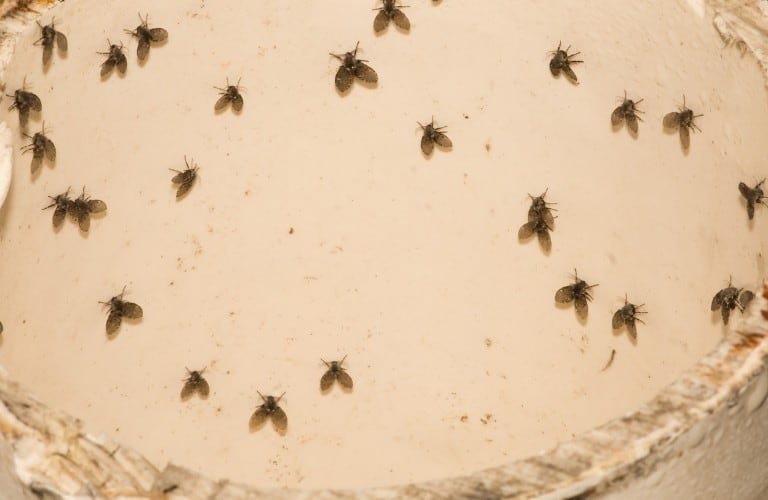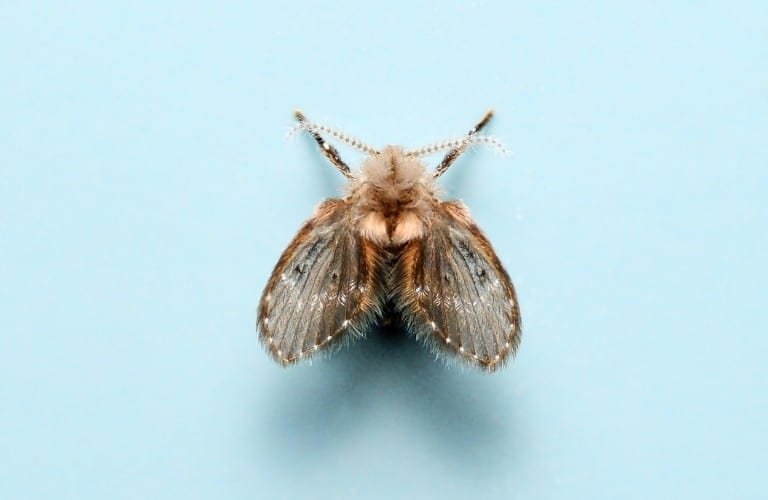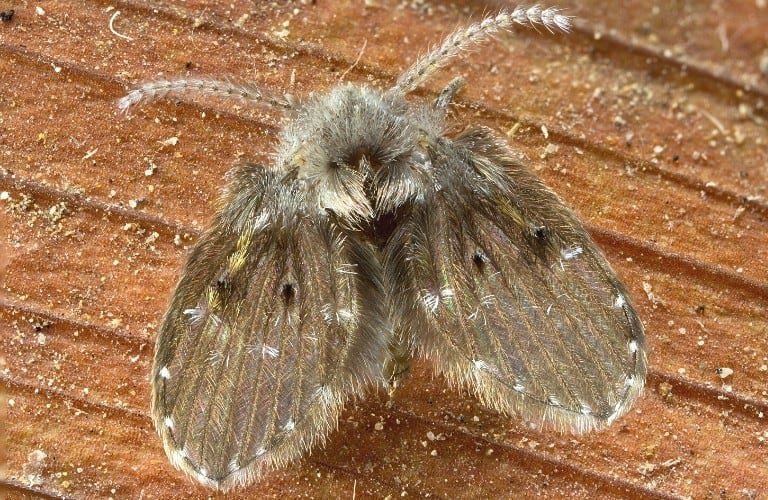Drain flies are tiny, bothersome little bugs that seem to spontaneously appear in kitchens and bathrooms.
Taking care of them quickly is important to avoid a widespread infestation, but to eliminate them you must know what causes them to invade your home.
What causes drain flies? Drain flies are attracted to stagnant water that contains decaying organic material, which is often found in the drains and pipes of sinks, showers, and bathtubs. The moisture and organic material provide ideal conditions for drains flies to live and breed.
Seeing drain flies in and around your drains is not pleasant and can be downright embarrassing when you have company over.
Thankfully, it’s not too difficult to remove their source of attraction and eliminate the problem, but you need to go about it the right way. We’ll show you exactly how in the following.
What Are Drain Flies?
Drain flies are also known as moth flies, sink flies, or sewer flies. They are joined by fruit flies, fungus gnats, and others to form the group generically known as “gnats.”
(We cover gnats extensively here – everything from why they buzz around your head to how they can kill your plants to how to get rid of them for good.)
These little bugs (1 – 5 millimeters long) have wings that look similar to a moth but do not fly long distances.
Instead, drain flies look like they are hopping or jumping instead of flying. This is one of their defining characteristics from other gnats.
(Many people confuse drain flies and fruit flies because of their small size and similar hovering behaviors. Learn how to tell them apart in this article.)
Drain flies look like they are covered in fur and have long antennae.
They do not bite, sting, or spread disease, but they can be a nuisance if allowed to reproduce unhindered.
In fact, drain flies reproduce at a rapid rate – one female can lay up to 300 eggs every 48 hours!
However, adults do not survive more than 24 days and are relatively easy to kill.
Why Do Drain Flies Live in Drains?
Drain flies need plenty of moisture to survive. They can often find this moisture in bathrooms, kitchens, and standing water.
These places also have plenty of nourishment for drain flies, whose diet consists of rotting organic material such as old food, human or animal feces, and grime.
This is why sewers, storm drains, and other plumbing situations are popular places for drain flies to live and breed.
You can also find drain flies in outdoor areas that have large amounts of organic waste, like leaky septic tanks and damp areas with animal feces that haven’t been cleaned up.
They can even infest sump pumps! We cover how to handle that situation here in this article.
They are also frequently found in swampy or flooded areas.
Drains in sinks, showers, and bathtubs are breeding grounds for drain flies because of the combination of moisture and decaying organic material that washes off the human body, such as sweat and old skin cells.
The film of stagnant water that collects on the sides of pipes and underneath drains makes a great place for drain flies to lay their eggs.
You might notice more drain flies than normal in bathrooms and sinks that have not been used recently.
This is because stagnant water mixed with decaying organic material develops a film on top. When the water is moved or flushed out, this film disappears.
You’ll find a ton of other interesting, helpful information on drain flies as well as key prevention and eradication tips in our series of drain fly articles. Click here to access them all.
How to Prevent Drain Flies
With the accelerated rate of drain fly reproduction comes a problem: when you see an adult drain fly, there is more than likely already a huge amount of larvae lurking within your pipes.
This makes prevention very important.
Flush Out Pipes Frequently
As mentioned above, drain flies make their homes and have their offspring in stagnant water.
Simply running the water in a sink, shower, or bathtub will get the water in the drainpipes and traps moving, making it less attractive to the drain flies.
This will not kill any existing larvae and will not even flush them all out, but it will help prevent adults from breeding.
Clean Bathrooms and Kitchen
By disinfecting these rooms, you will remove the sources of food for drain flies.
The more organic matter that is allowed to decay out in the open, the more drain flies (and other bugs) you’ll attract.
Take out garbage quickly, wipe up food remnants, flush toilets after every use, store food in airtight containers (these are ideal), and disinfect showers and bathtubs.
Unclog Drains
When showers, sinks, and bathtubs cannot drain properly, they attract drain flies.
Any standing water, whether it’s still in the sink or is sitting at the top of the drain, can be a home for drain flies.
Use a declogging gel product, like this one on Amazon, to clear pipes out when they’re draining slowly.
These products are not pesticides and will not kill larvae. However, they will help keep water moving, preventing the drain flies from entering in the first place.
How to Get Rid of Drain Flies
Getting rid of drain flies involves trapping or killing adult bugs and preventing larvae from maturing.
Follow the steps outlined below and be sure to check out our article “How To Get Rid of Drain Flies” for complete prevention guidelines and elimination strategies to rid your home of these pests once and for all.
Clean Out Pipes
Clean and disinfect any part of the pipe you can reach.
Remove the drain cover and use a paint scraper, knife, or other long utensil to scrape away the slime from the sides of the pipe.
Look for larvae – pale, translucent, flattened cylinders with black heads. Get rid of as many of these as possible from the drain.
If you have access to the drain trap, open it up. This is a prime spot for drain flies to breed since water can remain in the trap and stagnate.
Again, look for larvae in addition to cleaning out the slimy film.
If you’re dealing with a drain fly infestation in your toilet area, head over to this article for detailed instructions on removing your toilet to access the breeding ground.
Kill the Larvae
There are several homemade methods of killing larvae while they are in the drain and pipe area. Try them out for a chemical-free solution.
Chemicals are often too caustic for pipes and can damage the glue that holds them together.
Larvae stick to the sides of the drain and pipe with a strong adhesive. They will not be wiped out simply by running water.
Instead, pour half of a gallon of boiling water (or as close to boiling as you can safely get) down the drain. The steam and extreme heat of the water will kill most of the larvae.
Additional All-Natural Methods
For a super-powered option, add half of a cup of white vinegar to the boiling water.
The odor and natural power of the vinegar will kill the larvae without harming your pipes.
Another option is to pour half of a cup of baking soda down the drain followed by a cup of vinegar.
The baking soda and vinegar react with each other to create a fizzy, foamy effect that coats the pipes.
Leave this overnight and then flush it out the next morning with hot water.
If these ideas do not work, you can purchase a commercial product such as InVade Bio Drain Gel. This gel goes straight down the drain and covers the inside of the drain and pipes.
InVade is especially useful because it contains probiotics that consume the organic material in the pipes, removing the sources of food from drain pipes.
Another excellent option is Natural Armor Fruit and Drain Fly Killer. This all-natural gel is extra thick and clings to the pipe walls to eliminate eggs, larvae, and adults.
Best of all, it will keep working for months to ensure that new generations don’t become established.
Trap the Adults
Once the larvae are taken care of, the adults are no problem!
Create some homemade traps near the problem areas using items found around the home.
Pour half of a cup of water into a bowl, cup, or other container. Then add two or three drops of dish soap, two tablespoons of vinegar and two tablespoons of sugar.
Stir these ingredients together and leave them near the drain for a few days.
The drain flies will be attracted to the container by the sugar and vinegar, but will be stuck in the water because of the oily nature of the soap.
Or, pour a couple of inches of vinegar into a container and cover it with plastic wrap. Poke a few holes in the plastic and leave the trap for a few days.
Drain flies will be attracted to the moisture and organic matter and will go through the holes in the plastic, but will not be able to exit from them.
If these traps don’t work, you can purchase sticky traps, like these, or try a UV light trap like the Katchy Indoor Insect Trap.
The Katchy uses a UV light to attract drain flies and other bugs to it and has a gentle fan to suck them into a canister.
At the bottom of the canister is a sticky glue trap. Once the bugs get sucked into the canister, they get stuck to the glue where they eventually die.
Be sure to read “Best Trap for Drain Flies” for additional options and to learn what to look for when purchasing drain fly traps (because not all bug traps work for drain flies).
Conclusion
Drain flies are insects that survive on decaying organic material and standing water. These are two things that often occur in sink, shower, and bathtub drains.
The film inside the drains and pipes of your home is an excellent place for drain flies to breed and leave behind their larvae.
The best way to avoid a drain fly infestation is to prevent them by removing decaying organic material and standing water from your home.
If you already have drain flies in your home, eliminate them by trapping the adults and killing the larvae inside the pipes.








